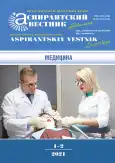Изучение распространенности аномалии прорезывания различных групп зубов у пациентов, обратившихся за ортодонтической помощью
- Авторы: Ищенко Е.А.1, Попов Н.В.2
-
Учреждения:
- Общество с ограниченной ответственностью «Стоматологическая клиника Спектр»
- Федеральное государственное бюджетное образовательное учреждение высшего образования «Самарский государственный медицинский университет» Министерства здравоохранения Российской Федерации
- Выпуск: Том 21, № 1-2 (2021)
- Страницы: 37-40
- Раздел: 14.01.00 Клиническая медицина
- URL: https://ogarev-online.ru/2410-3764/article/view/108825
- DOI: https://doi.org/10.55531/2072-2354.2021.21.1.37-40
- ID: 108825
Цитировать
Полный текст
Аннотация
- Обоснование. Ретенция зубов приводит ко многим эстетическим, функциональным нарушениям и к общему ухудшению качества жизни человека. Отечественные и зарубежные ученые указывают на увеличение количества обращений по поводу ретенции зубов. Несмотря на то что обращаемость за ортодонтической помощью среди пациентов с ретенцией зубов является чрезвычайно высокой, нет единого мнения о распространенности задержки прорезывания зубов.
Цель исследования — провести анализ распространенности аномалии прорезывания различных групп зубов у пациентов, обратившихся за ортодонтической помощью.
Материалы и методы. Исследование проводилось на клинических базах кафедры стоматологии детского возраста и ортодонтии и кафедры стоматологии ИПО Самарского государственного медицинского университета в 2017–2020 гг. Был проведен ретроспективный анализ 423 историй болезни ортодонтичеcких пациентов в возрасте 18–32 лет и клиническое обследование 134 стоматологических пациентов в возрасте 18–36 лет. Всего были исследованы показатели 557 пациентов, из них 236 женщин и 321 мужчины.
Результаты. При ретроспективном анализе 423 историй болезни у 72 пациентов (17,02 %) была обнаружена ретенция 104 зубов. Проведено клиническое обследование 134 ортодонтических пациентов в возрасте 18–36 лет, у 15 пациентов (11,19 %) обнаружилась ретенция 23 зубов.
Заключение. При ретроспективном анализе на верхней челюсти в превалирующем большинстве ретенированными зубами являлись моляры (у 20 пациентов, 62,5 %), вторыми по частоте ретенции — клыки (у 7 пациентов, 21,88 %). На нижней челюсти также в большинстве случаев ретенированными зубами являлись моляры (у 59 пациентов, 81,94 %), вторыми по частоте ретенции — премоляры (у 8 пациентов, 11,12 %). В ходе клинического обследования 134 ортодонтических пациентов в возрасте 18–36 лет у 15 пациентов (11,19 %) обнаружилась ретенция 23 зубов. В превалирующем большинстве ретенированными зубами являлись моляры — из них на верхней челюсти 56,52 %, а на нижней челюсти — 85,71 %; вторыми по частоте ретенции являлись клыки: на верхней челюсти — 26,09 % и на нижней челюсти — 14,29 %.
Ключевые слова
Полный текст
Открыть статью на сайте журналаОб авторах
Екатерина Александровна Ищенко
Общество с ограниченной ответственностью «Стоматологическая клиника Спектр»
Автор, ответственный за переписку.
Email: ishchenko.stom@mail.ru
врач-ортодонт
Россия, СамараНиколай Владимирович Попов
Федеральное государственное бюджетное образовательное учреждение высшего образования «Самарский государственный медицинский университет» Министерства здравоохранения Российской Федерации
Email: 2750668@mail.ru
заместитель директора института стоматологии, доктор медицинских наук, профессор кафедры стоматологии детского возраста и ортодонтии
Россия, СамараСписок литературы
- Гасымова З.В. Современные подходы к диагностике и лечению ретинированных зубов // Вестник Российской академии медицинских наук. 2014. Т. 69, № 3–4. С. 14–18. doi: 10.15690/vramn.v69i3-4.989
- Sajnani A.K., King N.M. Prevalence and characteristics of impacted maxillary canines in Southern Chinese children and adolescents // J Investig Clin Dent. 2014. Vol. 5, No. 1. P. 38–44. doi: 10.1111/jicd.12027
- Camilleri S., Lewis C.M., McDonald F. Ectopic maxillary canines: segregation analysis and a twin study // J Dent Res. 2008. Vol. 87, No. 6. P. 580–583. doi: 10.1177/154405910808700606
- Chu F.C., Li T.K., Lui V.K., et al. Prevalence of impacted teeth and associated pathologies – a radiographic study of the Hong Kong Chinese population // Hong Kong Med J. 2003. Vol. 9, No. 3. P. 158–163.
- Litsas G., Acar A. A Review of early displaced maxillary canines: etiology, diagnosis and interceptive treatment // Open Dent J. 2011. No. 5. Р. 39–47. doi: 10.2174/1874210601105010039
Дополнительные файлы












